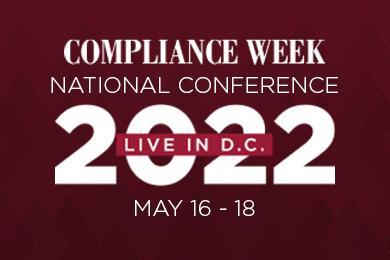Editor’s note: Compliance Week’s National Conference is back in-person for the first time in nearly three years. The event, held May 16-18 at the JW Marriott Hotel in Washington, D.C., features a robust agenda of keynotes, small-room panels, interactive workshops, and more.
Check out the full agenda

The National Conference agenda features a new format on Day 1, nine keynote-type sessions, 21 smaller room panels, more than a dozen intimate boardroom-style “conversations,” four interactive workshops, a VIP think tank, a women’s brunch, and plenty of time for networking. Use code CWKN200 at registration for $200 off.
Krista Haugner Sieg, senior compliance training and communications leader at GE Healthcare, will lead a workshop titled, “Making Engagement and Effectiveness a Reality - Building the Right Training for your Employees and Business.” She recently caught up with Compliance Week to offer a preview of her session and the topics to be discussed.
Q. Tell me about your experience as a compliance trainer. What do you like about it? What are some of the challenges?
A. For most of my corporate training career I have worked globally, but in my current role, I get to work with so many corners of the business, giving me more insights into how our business works and where various groups have their own challenges. As someone who loves to learn and share what I’ve learned, there is nothing like being able to keep learning, share best practices, and think strategically about what is right for our business in terms of training and communications.
That’s not to say there are never challenges. People often come with a prejudgment when it comes to compliance training. Additionally, there can be tension between developing training that is engaging and informative and having things like legal language on slides so people know what laws the rules are coming from. Working with key leaders, we can typically come to a balance on these things, but there is some change management here, too.
Q. What are some of the qualities of a successful compliance training tool?
A. One that you will use! In all seriousness, whatever tool you select, it must be one that meets your needs while also being something you can use and manage. For our team, one critical piece of compliance training is trackability, so we need tools that can track the completion of training or help us take attendance.
When it comes to training tools, you must consider:
- Is it easy for employees to use and find?
- Can it support the training we are planning to do while also supporting legacy training?
- Is it mobile compatible—especially for your workforce that is on the go or in the field?

Q. What are some of the qualities of an unsuccessful tool?
A. Complicated, confusing, and difficult to maintain are an automatic ‘no’ for me. I am always learning new tools, whether it is a new learning management system (LMS), new virtual delivery platform, or new tool for interactions. It always comes back to does it meet the use case and user stories that we need the tool to cover. Even when it is the most exciting tool, if it doesn’t align with our needs, then it is an unsuccessful tool.
Q. Interaction seems to be a key to success. How do you get employees involved in compliance training?
A. For most people to engage and interact, they want to know why they are there. There also needs to be the time and space to engage. But those things are just the baseline.
When developing live or virtual live training, one of my favorite interactions to start with is a word cloud to ask people what they already know about the topic, what they are most excited to learn, or even why they think we are doing the training. This is a great way to pulse the audience upfront to make sure the training is impactful. This pulse point is the beginning, not the end, of interactions. You will need to have continued interactions throughout to keep people engaged.
Another favorite of mine is using realistic scenarios, which are good for both live training and e-learning. If someone can put themselves in the shoes of the scenario, it will have a bigger impact.
Humor can be a great tool, or it can totally take any training or communication off track. Before deciding if you would like to use humor, you must consider your audience.
Q. What are some tips for helping employees remember their compliance training? Do you recommend regular follow-ups or check-ins? If so, how often?
A. Whether compliance or another type of training, interactivity and repeated exposure are critical for moving new material into memory. Too often, people set up a training experience thinking the audience is going to walk away and be an expert on 20 topics after 30 minutes. I would rather someone leave with the big picture and know where to find an answer or whom to go to for help then assume they know everything and make preventable errors.
We have a compliance portal where people can go to find policies, quick guides, and other reference materials. Employees can go here and pull whatever they need whenever they need it. It also means at the end of every training I am giving the same one place to go, which increases the likelihood of retention.
Our goal is for people to have more general awareness of what we are considering in terms of risk and role. Ultimately, how often you follow-up or check-in will have to do with the risk impact on your company, how new the concept is, or how new your workforce is. Higher turnover or something new requires many more touchpoints for it to become part of a culture. Once it is more commonplace, the frequency likely will have more to do with the risk level. Either way, this is a great place to involve leadership at all levels of your organization to drive the message.


















No comments yet